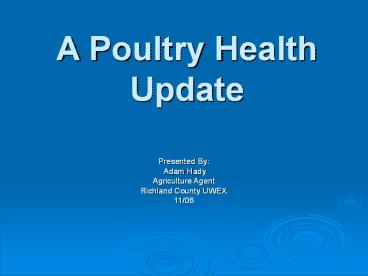A Poultry Health Update - PowerPoint PPT Presentation
Title:
A Poultry Health Update
Description:
A Poultry Health Update Presented By: Adam Hady Agriculture Agent Richland County UWEX 11/06 Topics of the Presentation Avian Influenza Mites and Lice Respiratory ... – PowerPoint PPT presentation
Number of Views:99
Avg rating:3.0/5.0
Title: A Poultry Health Update
1
A Poultry Health Update
- Presented By
- Adam Hady
- Agriculture Agent
- Richland County UWEX
- 11/06
2
Topics of the Presentation
- Avian Influenza
- Mites and Lice
- Respiratory Diseases
- Establishing a Biosecurity plan
3
Avian Influenza
- What is it?
- Why are we so concerned?
4
Low Path AI
- Mild or no clinical signs in poultry
- Decreased egg production
- Mild respiratory signs cough, sneeze
- Feces, ocular, oral and nasal secretions
- Bird-to-bird or contaminated equipment
- Diagnosis
- Virus isolation
- Serology
Source AVIAN INFLUENZA / BIRD FLU,
5
High Path AI
- Sudden death without clinical signs
Source AVIAN INFLUENZA / BIRD FLU,
6
High Path AI
- Decreased activity and decreased feed consumption
F.A.O.- Italy
Source AVIAN INFLUENZA / BIRD FLU,
7
High Path AI
- Decreased egg production
- Soft-shelled or misshapen eggs
Source AVIAN INFLUENZA / BIRD FLU,
8
High Path AI
- Swelling of head, eyelids, comb, wattles and hocks
Source AVIAN INFLUENZA / BIRD FLU,
9
High Path AI
- Purple discoloration (cyanosis and hemorrhage) of
wattle, comb and legs
Source AVIAN INFLUENZA / BIRD FLU,
10
High Path AI
- Nasal discharge, coughing, sneezing
- Lack of coordination
- Diarrhea
F.A.O.- Italy
Source AVIAN INFLUENZA / BIRD FLU,
11
Gross Lesions HPAI
- Vesicles and ulcers on comb
- Facial edema
Source AVIAN INFLUENZA / BIRD FLU,
12
Gross Lesions HPAI
- Hemorrhage throughout internal body organs and
fat
Source AVIAN INFLUENZA / BIRD FLU,
13
Gross Lesions HPAI
- Hemorrhage throughout internal body organs
- and fat
Source AVIAN INFLUENZA / BIRD FLU,
14
Other Health Concerns
- Mites Lice
15
Mites Lice
- Mites
- Size 1 millimeter in diameter
- Color Dark Reddish Black
- Egg Color Location
- White to off-white along the feather shaft
- Mites live on the host and in the environment
16
Mites Lice
- Lice
- Size 2-3 millimeters long
- Color Light Brown
- Egg Color Location
- White and at the base of the feather
- Lice only live on the host, and appear to be fast
moving.
17
Mites Lice
- Symptoms
- Decreased Food Intake
- Decreased Egg Production
- Decreased Weight Gain
- Increased Susceptibility to Other Diseases
- If any of these symptoms are observed a visual
inspection around the vent for lice or mites is
recommended.
18
Mites Lice
- Treatment
- Sanitation and cleanliness are keys to control
- Chemical control
- Dust bath with Sevin
- Pyrethrin-Based spray
- Ivermectin medication
19
Respiratory Diseases
- These are some of the most common diseases of
poultry. - They cause a wide variety of impact on the flock,
from production loss to mortality.
20
Respiratory Diseases
- There are many causes and is very common
- Signs
- Coughing
- Sneezing
- Discharge from the eyes and nostrils
21
Respiratory Diseases
- Causes
- Viruses
- Bacteria
- Parasites (such as the gapeworm)
- High ammonia levels
22
Respiratory Diseases
- Vectors
- Other Chickens
- Rodents
- Manure
- Dust
23
Backyard Biosecurity
- What is Biosecurity
- Measures that are taken to prevent the transfer
of diseases from place to place and animal to
animal.
24
Six Steps To Biosecurity
- 1. Keep Your Distance
- 2. Keep It Clean
- 3. Dont Haul Disease Home
- 4. Dont Borrow Disease
- 5. Be Informed
- 6. Report Sick Birds
25
Biosecurity Plan
- What is it?
- A biosecurtiy plan is written document that
outline procedures for preventing and handling
diseases. - Are they practical for me?
- Yes, no matter what your size of operation it is
worth taking time to look at how to minimize
disease threats.
26
Building a Biosecurity Plan
- The first step
- What am I currently doing?
- Housing
- Feeders and Waterers- how are they located?
- What kinds of birds are commingled?
- What age groups of birds do I have?
- What are my feed sources?
- How do I bring new birds into the flock?
- How do I handle dead birds?
- Etc.
27
Building a Biosecurity Plan
- Step Number Two
- Identify the areas where diseases could be
introduced - Identify areas where cross contamination could
occur.
28
Building a Bio Security Plan
- Step Number Three
- Outline ways that you could prevent
contamination from your list in step 2 - Step Number 4
- Follow your Plan
29
References
- AVIAN INFLUENZA / BIRD FLU, PowerPoint
presentation by Ron Kean , UW-Extension Poultry
Specialist, 2006 - Common External Parasites in Poultry Lice and
Mites Ohio State University Fact Sheet - Backyard Biosecurity Practices to Keep Your
Birds Healthy UDSA/ APHIS publication May 2004 - American Poultry Association Website
http//www.amerpoultryassn.com/
30
Questions ???































